
The Jubilee line is a London Underground line that runs between Stanmore in suburban north-west London and Stratford in east London, via the Docklands, South Bank and West End. Opened in 1979, it is the newest line on the Underground network, although some sections of track date back to 1932 and some stations to 1879.

The Honourable Society of Lincoln's Inn, commonly known as Lincoln's Inn, is one of the four Inns of Court in London. To be called to the bar in order to practise as a barrister in England and Wales, an individual must belong to one of these inns. The other three are Middle Temple, Inner Temple, and Gray's Inn.
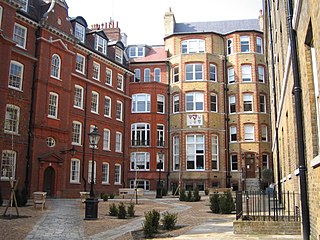
The Honourable Society of the Inner Temple, commonly known as the Inner Temple, is one of the four Inns of Court and is a professional association for barristers and judges. To be called to the Bar and practise as a barrister in England and Wales, a person must belong to one of these Inns. It is located in the wider Temple area, near the Royal Courts of Justice, and within the City of London. As a liberty, it functions largely as an independent local government authority.

Foyles, a trading name of Waterstones Booksellers Limited, is a bookseller with a chain of seven stores in England. It is best known for its flagship store in Charing Cross Road, London. Foyles was once listed in the Guinness Book of Records as the world's largest bookshop in terms of shelf length, at 30 miles (48 km), and of the number of titles on display. It was bought by Waterstones in 2018.

Peter Jones & Partners is a large department store in central London. It is owned by John Lewis & Partners and located in Sloane Square, Chelsea. The store holds two royal warrants granted by Charles, then Prince of Wales, and Prince Philip, Duke of Edinburgh.

St Mary Aldermary is an Anglican church located on Bow Lane at the junction with Watling Street, in the City of London within the United Kingdom.

The Black Eagle Brewery is the former brewing plant of Truman's Brewery located around Brick Lane in the Spitalfields area, in the London Borough of Tower Hamlets. Truman's subsequently became Truman, Hanbury and Buxton. By 1853, the Black Eagle Brewery was the largest in the world, with an annual production of 400,000 barrels.
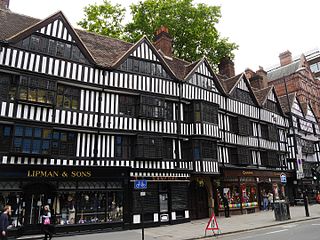
Staple Inn is a part-Tudor building on the south side of High Holborn street in the City of London, London, England. Located near Chancery Lane tube station, it is used as the London venue for meetings of the Institute and Faculty of Actuaries, and is the last surviving Inn of Chancery. It was designated a Grade I listed building in 1974.

Ede & Ravenscroft are the oldest tailors in London, established in 1689. They have two London premises, in Chancery Lane and Burlington Gardens, very close to the famous Savile Row. They make, sell and hire out legal gowns and wigs, clerical dress, civic and municipal robes, academic dress and other ceremonial and formal dress, and have shops in Oxford, Cambridge and Edinburgh.

Enon Chapel was a building on Clement's Lane off Aldwych near the Strand in London and it was built around 1823. The upper part was dedicated to the worship of God, with the dead buried in a vault beneath, separated by a board floor. The chapel was notorious for allegations that thousands of bodies had been packed into the vault room in the space of 20 years.

Serjeant's Inn was the legal inn of the Serjeants-at-Law in London. Originally there were two separate societies of Serjeants-at-law: the Fleet Street inn dated from 1443 and the Chancery Lane inn dated from 1416. In 1730, the Fleet Street lease was not renewed and the two societies merged. The society's relevance diminished as Serjeants-at-Law were gradually superseded by Queen's Counsel in the nineteenth century. The building in Chancery Lane was sold in 1877 and the assets were distributed amongst the surviving members, although the society was not formally dissolved. The last member, Lord Lindley, died in 1921. The Fleet Street building was destroyed in the 1941 bombing raids during World War II.
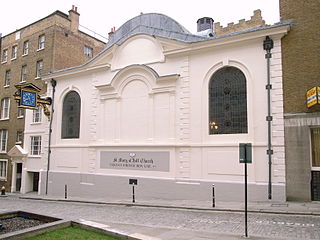
St Mary-at-Hill is a Church of England parish church in the Ward of Billingsgate, City of London. It is situated on Lovat Lane, a cobbled street off Eastcheap.
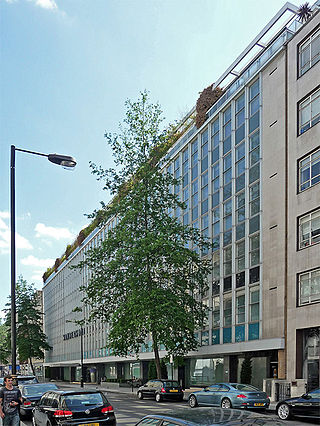
The Sanderson Hotel is a hotel on Berners Street, London, built in 1958 as the new headquarters and showroom for Arthur Sanderson and Sons, manufacturers of wallpaper, fabrics and paint, for the company's centennial. The building was designed by architect Reginald Uren, of the architectural firm, Slater and Uren. The original design allowed for dynamic room configurations. The building surrounds a courtyard with a Japanese garden designed by Philip Hicks. The Sanderson building was listed Grade II* by English Heritage in 1991. After refurbishment by Philippe Starck and Denton Corker Marshall, it was reopened by Morgans Hotel Group as the Sanderson Hotel on 25 April 2000.

All Hallows, Honey Lane was a parish church in the City of London, England. Of medieval origin, it was destroyed in the Great Fire of London in 1666 and not rebuilt; the site became part of Honey Lane Market, which was in turn partially cleared to make way for the City of London School in the 19th century. Much of the area was destroyed during the bombing in World War II and has been redeveloped. The name Honey Lane is retained in a nearby walkway.

St Botolph's, Billingsgate was a Church of England parish church in London. Of medieval origin, it was located in the Billingsgate ward of the City of London and destroyed by the Great Fire of London in 1666.
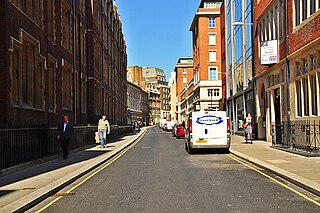
Chancery Lane is a one-way street that forms part of the western boundary of the City of London. The east side of the street is entirely within the City, whilst the west side is in the City of Westminster south of Carey Street and the London Borough of Camden north of that street. The route originated as a 'new lane' created by the Knights Templar from their original 'old Temple' on the site of the present Southampton Buildings on Holborn, in order to access to their newly acquired property to the south of Fleet Street sometime before 1161.

Holy Trinity, Minories, was a Church of England parish church outside the eastern boundaries of the City of London, but within the Liberties of the Tower of London and therefore in the East End of London. The liberty was incorporated in the Metropolitan Borough of Stepney in 1899, and today is within the City of London. Converted from the chapel of a nunnery, Holy Trinity was in use as a church from the 16th century until the end of the 19th century. It survived as a parish hall until it was destroyed by bombing during World War II.
Thavie's Inn was a former Inn of Chancery, associated with Lincoln's Inn, established at Holborn, near the site of the present side street and office block still known as Thavies Inn Buildings. Thavie's Inn is one of the earliest Inns of Chancery on record, both by date of establishment and dissolution. It remains a well-known City of London landmark, where Lloyd's Bank is situated, on the opposite side of Holborn Circus from Ely Place.

Stone Buildings, Lincoln's Inn were constructed from 1774 to 1780. The architect was Sir Robert Taylor. Stone Buildings is a Grade I listed building. Stone Buildings appear in Anthony Trollope's novel The Prime Minister.

The Inns of Court Officers Training Corps Memorial is a First World War memorial near Berkhamsted, in the west of Hertfordshire. It is now on land that forms part of Berkhamsted Golf Course. The stone obelisk was erected c.1920, close to the temporary training camp of the corps on Berkhamsted Common which operated from 1914 to 1919. It became a Grade II listed building in November 2016.



















